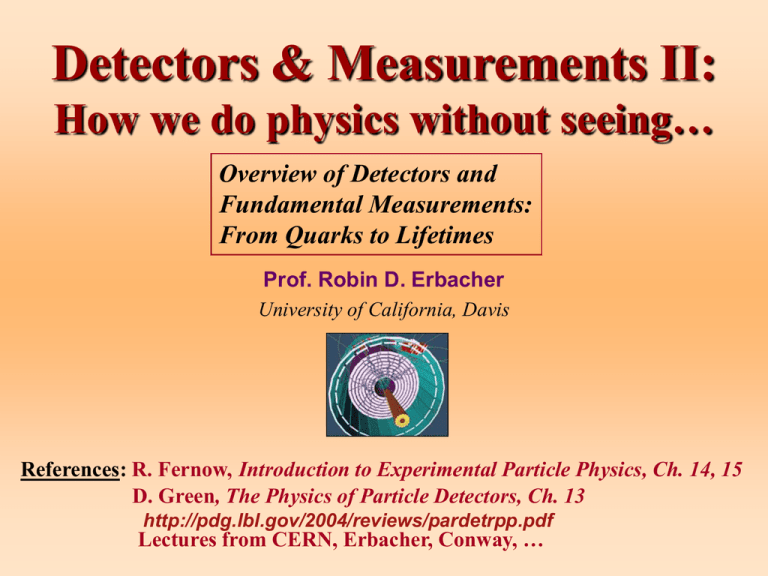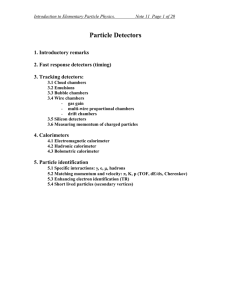252b Lecture 4: Detectors and Measurements
advertisement

Detectors & Measurements II: How we do physics without seeing… Overview of Detectors and Fundamental Measurements: From Quarks to Lifetimes Prof. Robin D. Erbacher University of California, Davis References: R. Fernow, Introduction to Experimental Particle Physics, Ch. 14, 15 D. Green, The Physics of Particle Detectors, Ch. 13 http://pdg.lbl.gov/2004/reviews/pardetrpp.pdf Lectures from CERN, Erbacher, Conway, … Modern Collider Detectors • the basic idea is to measure charged particles, photons, jets, missing energy accurately • want as little material in the middle to avoid multiple scattering • cylinder wins out over sphere for obvious reasons! Call ‘em Spectrometers • a “spectrometer” is a tool to measure the momentum spectrum of a particle in general • one needs a magnet, and tracking detectors to determine momentum: dp q vB dt c • helical trajectory deviates due to radiation E losses, spatial inhomogeneities in B field, multiple scattering, ionization • Approximately: p 0.2998B T - m = radius of curvature Magnets for 4 Detectors Solenoid + Large homogeneous field inside - Weak opposite field in return yoke - Size limited by cost - Relatively large material budget Examples: •Delphi: SC, 1.2 T, 5.2 m, L 7.4 m •L3: NC, 0.5 T, 11.9 m, L 11.9 m •CMS: SC, 4 T, 5.9 m, L 12.5 m Toroid + Field always perpendicular to p + Rel. large fields over large volume + Rel. low material budget - Non-uniform field - Complex structural design Example: •ATLAS: Barrel air toroid, SC, ~1 T, 9.4 m, L 24.3 m LHC Coils Different Two ATLAS toroid coils Superconducting CMS Solenoid Design Charge and Momentum CMS at CERN S = Solenoid! CMS Muon Chambers CMS Spectrometer Details • 12,500 tons (steel, mostly, for the magnetic • • • • • • • return and hadron calorimeter) 4 T solenoid magnet 10,000,000 channels of silicon tracking (no gas) lead-tungstate electromagnetic calorimeter 4π muon coverage 25-nsec bunch crossing time 10 Mrad radiation dose to inner detectors ... CMS: All Silicon Tracker All silicon: pixels and strips! 210 m2 silicon sensors 6,136 thin detectors (1 sensor) 9,096 thick detectors (2 sensors) 9,648,128 electronics channels Possible Future at the ILC: SiD All silicon sensors: pixel/strip tracking “imaging” calorimeter using tungsten with Si wafers Fixed Target Spectrometers •Fixed target experiments study what happens when a beam of particles smashes into the atoms of a target. •Most beam energy goes into target recoil, a fraction left to create new particles •Particles produced, or scattered, generally fly forwards •Detectors are typically cone-shaped, and placed downstream of the beamline. Fixed Target Experiments If we think of collider experiments as power tools for a broad range of discoveries, we can think of fixed-target experiments as a set of scalpels to dissect particular particles and processes. The machine tool versus the surgeon's knife. - particle Atom Rutherford’s discovery of the nucleus pioneered fixed-target experiments. b impact parameter Later such experiments found partons, and have continued to illuminate particle physics. Probing the Structure of Matter SLAC Endstation A: Electrons on nucleons Probing the Structure of Matter Kinematic reach is physical: Need to arrange spectrometer According to physics desired Polarized target material: Frozen NH3 and ND3 Secondary Beam Particles KTeV: Kaons at the TeVatron The KTeV experiment was designed to search for direct CP violation in K -> 2 pion decays, and to study a wide variety of rare KL decays. Studying Secondary Particles Studying Secondary Particles Intense beam of K0s created from TeV energy protons Using Secondary Beams as Probes NuTeV: Neutrinos at the Tevatron DIS •Ten sq ft on the face, 120 ft long •690 tons of steel, 84 scintillator boxes in target cal •Toroidal magnetic field •Muon drift chambers Structure of Nucleon, and sin2w Neutrino Target & Product Detector Using Secondary Beams as Probes Charged Current CC Interaction q - X NC /CC sin 2 w Neutral Current NC Interaction q X Secondary Beams as Probes Fundamental Measurements Next time… Discussion of measurement of fundamental parameters in particle physics. Fundamental Measurements Charge: Charge of a particle can be determined two ways 1) Direction of deflection in a magnetic field 2) Charge-dependent quantity, such as ionization energy loss Mass:







